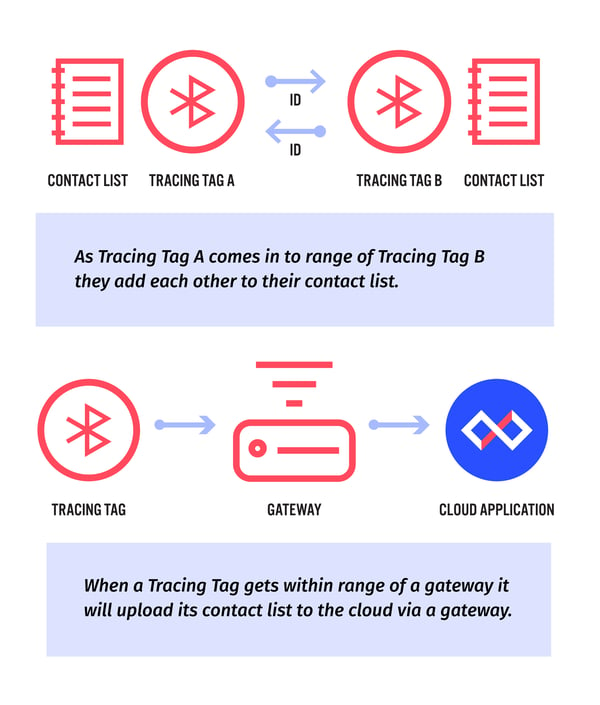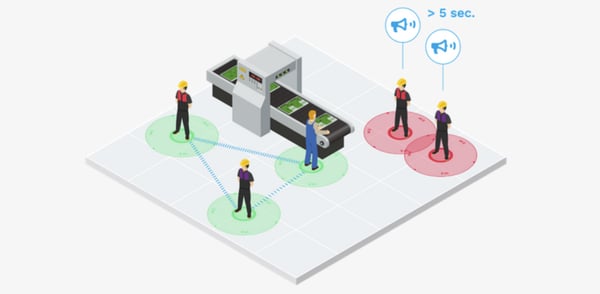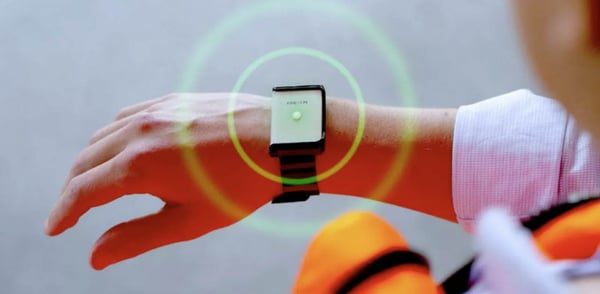Companies are safely reopening workplaces and mitigating risks through contact tracing with IoT. Because this is a relatively new use case and there are not many out-of-the-box solutions, selecting hardware can be particularly challenging. Here at Losant, we’ve been helping companies turn employee contact tracing into a reality. In doing so, we’ve evaluated multiple types of hardware and connectivity and found that Bluetooth (BLE) and Ultra-Wideband (UWB) lend themselves well to contact tracing.
Questions to Consider:
To help you determine which hardware is right for your company and needs, consider the following:
Architecture
- Are there privacy concerns around employee location?
- How will your organization repurpose this hardware for different use cases in the future?
- What is the scale of the project?
- How are employees organized?
- How many locations will this be implemented in, and do those locations have different requirements?
- What is the per-employee budget for the project?
Hardware
- How important is distance accuracy to your organization?
- What form factor will make for an effective solution (i.e., wristband, belt clip, lanyard)?
- Do you want to implement real-time social distancing alongside historic contact tracing?
- What kind of real-time feedback are you looking for (i.e., audio, visual, haptic)?
- Does the hardware need to be rated or certified (i.e., IP67, Class 1 Div 1, etc.)?
Contact Tracing Architecture
There are two main models for contract tracing: location-based and interaction-based.

Location-based contact tracing records the paths that employees or customers travel within the space. This is done through triangulation—three gateways are placed in a space, and the distance of a tag from each of them is recorded in order to determine location. In this case, technologies like LoRa or UWB may be good fits.
Interaction-based contact tracing records employee or customer interactions with one another instead of recording location. This is done by measuring distance between two people as well as time spent at that distance. This can be measured, recorded, and stored locally through on-device firmware and then that data can be sent up to the cloud at a later time to have an up-to-date ledger of all contacts made. Technologies like Bluetooth and UWB are good for this model.
Losant follows the interaction-based architecture.
Losant’s Contact Tracing Methodology
Losant uses an interaction-based model because it allows for employee privacy along with cost savings.
The interaction-based contact tracing methodology revolves around employees interacting with other employees, not around location. Without reporting location, the model notes when employees come into contact with one another for a specific amount of time and only reports that “contact list” data up to the Losant application: tag ID, the tag ID of the other employee, time of contact, length of contact, and distance between tags. This allows companies to collect anonymous data that can then be sent to an HR system and matched with employees in the case of a positive COVID-19 result. From there, a company can view and contact each person the positive employee came in contact with, per their HR policies. This model can work for both an employee-based deployment or shift-based deployment and is hardware agnostic, but follows the following architecture: As an employee goes throughout his or her day, the tag works offline. It utilizes onboard firmware to record every time it comes in contact with another tag (another employee). This can also be used for real-time social distancing, alerting employees when they’re too close to another employee for too long through audio, haptic, or visual feedback.
As an employee goes throughout his or her day, the tag works offline. It utilizes onboard firmware to record every time it comes in contact with another tag (another employee). This can also be used for real-time social distancing, alerting employees when they’re too close to another employee for too long through audio, haptic, or visual feedback.
When the tag is in the vicinity of a gateway, it uses BLE to send the list of contacts to the gateway, which will then use WiFi or cellular to upload that historical data to the cloud. Then, it clears out the list of contacts on the device itself.

This methodology provides two main benefits over a location-based contact tracing architecture: privacy and cost-savings. For many companies and HR departments, employee privacy is a concern. Employees don’t want their X, Y coordinates tracked and reported back to their employer—it strips them of a sense of privacy. The interaction-based architecture means that location data isn’t even tracked, much less shared with the employer. Additionally, an interaction-based model means that constant triangulation is not occurring. The tags operate offline with onboard firmware until they come in contact with a strategically-placed gateway. For many of our customers, that means placing gateways in lobbies, entrances/exits, break rooms, and elevator bays. By putting gateways in only key areas, fewer gateways are needed for a solution to be deployed campus or building-wide, which means deployment cost savings.
To deploy such a solution with Losant either BLE or UWB hardware can be used. Each has strengths and weaknesses, depending on your needs.
Bluetooth
BLE is a short-range wireless network connectivity that has high bandwidth. The technology is used commonly in consumer products as well as in building automation projects. BLE connectivity is a great first consideration for a contact tracing solution because of the cost to scale.
Bluetooth hardware is affordable. For projects with hundreds of thousands of employees, a per-employee cost can add up. Tags range from ~$12 per tag to ~$30 per tag. Losant’s solution uses the RSSI value to determine the distance between tags. This method works best for employees working apart in well-distanced spaces where the important information is that a contact within a distance was made. Exact measurements are better achieved with UWB.
The Losant team has been focused on contact tracing through BLE. We’ve put together a standard pilot deployment with six gateways and 100 BLE wristbands. If you’d like to learn more, download the Contact Tracing Solution Framework.

Ultra-Wideband
In cases where employees are working closely together, a solution focused on accuracy may be a better fit. UWB technology is another great way for organizations to actualize contact tracing with the same architecture as the BLE solution.
UWB is a low-energy connectivity that also works well for short-range, high-bandwidth applications. In this way, UWB is similar to BLE. The two main differences come in the form of accuracy and cost. UWB touts a margin of error of just a couple of centimeters, making this generally a great option for indoor positioning of high-value assets. This accuracy, as expected, comes at a cost. Tags range between ~$60 per tag to ~$120 per tag, depending on the requirements for hardware. This makes UWB relatively expensive at scale.
When employee contacts are frequent or when employees work in close quarters, UWB is a much more effective solution. One of our solutions partners, Skylytics, created an application called safercontact™ using Losant. This application is compatible with both UWB hardware and BLE hardware, allowing for deployment flexibility customized to your employee environments. Read more about their safercontact application.
Ready to Learn More?
Hear Losant and Skylytics speak more about contact tracing and how IoT is shaping the post-pandemic world at IoT Tech Expo North America on November 5 at 1:10 PM ET.
